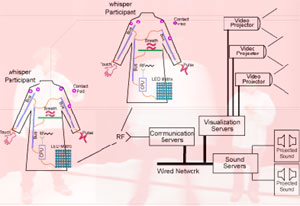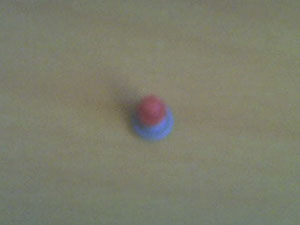Oopsie
Posted: 4 February 2006 Filed under: Critical Context Leave a commentAs you’ll see below, I’ve managed to get to the circuit board out but at a bit of a price. I cut a wire with the plan to crimp a male bullet connector on it and a female on the other end to re-join them. But the wire is too thin to stay in the connector even when I’ve suqeezed squeezed it together as much as I can so I think I’m gonna have to solder them. I haven’t soldered for a good few years but I’m hoping that as a skill it’s a bit like riding a bike but without the grazed knees.
As a plan B, I thought I’d try and get the bulbs out of their holders which then ought to allow me to lift the circuit board out anough enough to get at the underneath. I managed to get 3 out including the one with the cut wire but then one of the wires snapped on the 4th. I think it’s snapped off right near the bulb so I’m still gonna have to get it out some how. Hmm, if I repair the cut wire I’ll have 3 to experiement with which isn’t quite so bad. So I get my soldering iron out only to discover that it needs 14 hours to fully recharge!!! Fan-bloody-tastic. Looks like it’ll have to wait ’til tomorrow now. I hoipe hope Argyle win.


Machinima
Posted: 25 January 2006 Filed under: Critical Context, Ramblings | Tags: film, hack Leave a commentI’ve really started to get into machinima recently. I’ve seen a few episodes of Red vs Blue but that’s about it. During a talk given by Mike Salmond last week, he said he was interested in games as an art form and someone asked him what he thought about Machinima so I thought I’d have a look around. Machinima.com has loads listed as well as some tips on how to make them. World of Warcraft – Shutup and Dance! is well worth a look as is James Bond: No Licence but The Journey is just fantastic. It’s based on Unreal Tournament 2004 and couldn’t be more different. Then check out Person2184 which is also based on Unreal Tournament 2004.
Apart from them being visually stunning, I think I like them coz they match what I now consider to be the underlying idea of my project in that they’re following the true hacker’s remit that Wark talked about. They’re taking something, a finished product and building upon it to produce something else, something completely different to the original.
Whispers
Posted: 15 January 2006 Filed under: Critical Context, Ramblings | Tags: clothes, whispers Leave a commentWhispers is a really interesting project. It was put together by Kristina Anderson in collaboration with Thecla Schiphorst and Suzan Kozel. Whispers stands for Wearable Handheld Intimate Sensory Personal Expectant Response System and is a combination of textile and digital technology. It consists of clothing and wearable devices that collect data generated by the body and transmits them to other, nearby devices and a central server. They in turn provide feedback in the form of sound and tactile feedback devices that are also worn which lets the wearer interpret and react to their own and other people’s physiological data. Meanwhile, the server is projecting a representation of the data collected into the space. What I really like about this is the mixing of digital technology with clothing and the idea of using the body as an input device.

Hacker Manifesto
Posted: 8 January 2006 Filed under: Critical Context, Ramblings | Tags: book, hack 1 CommentJust finished A Hacker Manifesto by McKenzie Wark. Really interesting book where he talks about hacking being a class stuggle between people who produce and the corporates who own the things that hackers produce. Something he writes which I think is very relevant to my project is “Hacking is the production of production. The hack produces a production of a new kind, which has as its result a singular and unique product.” In this, he’s talking about hacking in the truest sense of the word not the meaning given to it by the media of systems and databases broken into for gain or vandalism. But of seeing a thing and wanting to chance change it into something else, or improve upon it. To produce a new thing from it.
Switches
Posted: 29 December 2005 Filed under: Critical Context Leave a commentSo it was a near disaster today. I opened up Simon, took out the screws holding the circuit board in place and lifted the board up and then all these “things” flew out. It turns out that these were the springs between the buttons and the board (see below). Did a quick count and 5 were missing. I eventually tracked them down after a good half-hour. Most were within a couple of feet from where I was sitting but 2 had managed to fly out the door which I reckon is around 4 feet away. Simon is back together again and in good working order – perhaps I should just investigate the elastic properties of plastic instead!!

Electronics kit
Posted: 22 December 2005 Filed under: Critical Context Leave a commentI’ve just finished working my way thru’ the electronics kit today. Not sure if I’m any more knowledgeable on how things work but at least I think I know the difference between a resistor and a capcitor capacitor now. I also know that a capacitor can store a charge so it’s not a good idea to take one apart shortly after turning the thing off. Hmm, maybe I learnt more than I thought. I’ve fallen behind my schedule by a couyple couple of days but I think there’s enough slack in my plan to be able to catch up.
Plan of attack v1.0
Posted: 29 November 2005 Filed under: Critical Context Leave a commentI’ve been thinking about how I should go about constructing the simontron and I’ve got a rough schedule of what I want and need to do.
Finish my introduction to electronics by completing the exercises in the hobby kit – 17/12
Find the contact points in Simon for hooking up “externals” – 31/12
Experiment with Simon, Wiring board and Processing and work out if any extra equipment is needed – 31/1
Decide on final “model” – 17/2
Construct “model” including writing of any additional code – 17/3
The Simontron
Posted: 28 November 2005 Filed under: Critical Context Leave a commentThe more I’ve been thinking about hacking Simon, the more I think he should have a name. Something really cool and retro-futuristic. So I came up with The Simontron. I’ve just done a quick Google to make sure I’m not gonna get sued by Simontron Inc and apart from some Russian sites nothing showed up. So from now on, the project is called The Simontron.
Some favourite circuit-bending
Posted: 27 November 2005 Filed under: Critical Context Leave a commentThere are loads on this page but I particularly like the Speak&Maths, the Speak&Spell and Speak&Maths “talking” to each other and the chicco drum machine – http://www.circuitbenders.co.uk/soundz.html
Circuit-bending article
Posted: 26 November 2005 Filed under: Critical Context Leave a commentI’ve just discovered this article on Reed Ghazala – http://www.soundonsound.com/sos/mar00/articles/ghazula.htm who seems to be the daddy of circuit bending. What is interesting in the article, and from what I’ve found out so far, is the key seems to be to hack cheap, electronic toys. Firstly there’s the cost, it’s a lot less painful frying a cheap toy than an expensive Moog, but also there’s safety to consider. Toys tend to have low voltages and so you are less likely to get an electric shock than if you hacked a mains powered gizmo.
Reed also has a fantastic definition of circuit-bending. He sums it up as “Circuit-bending is the electronic art of the implementation of the creative audio short-circuit” – poetry!!